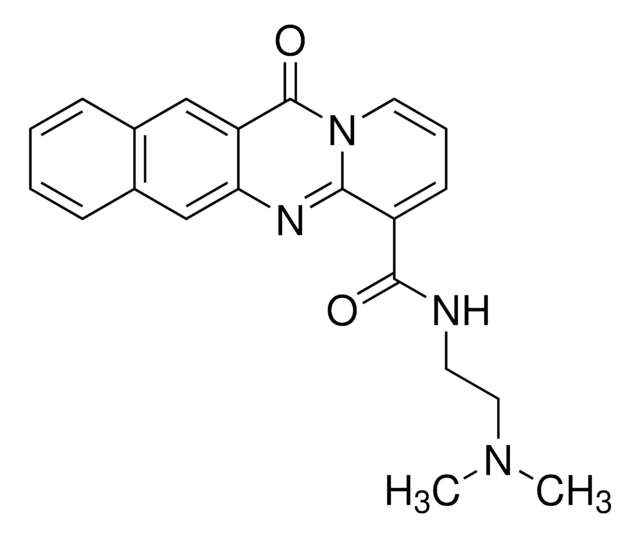557403
RNA Polymerase III Inhibitor
RNA Polymerase III Inhibitor, CAS 577784-91-9, is a cell-permeable inhibitor of RNA Polymerase III (IC₅₀ = 27 and 32 µM for human and S. cerevisiae RNA Pol III, respectively).
Sinónimos:
RNA Polymerase III Inhibitor, ML-60218, N-[1-(3-(5-Chloro-3-methylbenzo[b]thiophen-2-yl-1-methyl-1H-pyrazol-5-yl)]-2-chlorobenzenesulfonamide
About This Item
Productos recomendados
Nivel de calidad
Análisis
≥95% (HPLC)
formulario
solid
fabricante / nombre comercial
Calbiochem®
condiciones de almacenamiento
OK to freeze
protect from light
color
off-white
solubilidad
DMSO: 15 mg/mL
Condiciones de envío
ambient
temp. de almacenamiento
2-8°C
InChI
1S/C19H15Cl2N3O2S2/c1-11-13-9-12(20)7-8-16(13)27-19(11)15-10-18(24(2)22-15)23-28(25,26)17-6-4-3-5-14(17)21/h3-10,23H,1-2H3
Clave InChI
BVBDTTLISMIOJY-UHFFFAOYSA-N
Descripción general
Acciones bioquímicas o fisiológicas
activity against RNA Polymerase III
Envase
Advertencia
Nota de preparación
Reconstitución
Otras notas
Información legal
Código de clase de almacenamiento
11 - Combustible Solids
Clase de riesgo para el agua (WGK)
WGK 1
Punto de inflamabilidad (°F)
Not applicable
Punto de inflamabilidad (°C)
Not applicable
Certificados de análisis (COA)
Busque Certificados de análisis (COA) introduciendo el número de lote del producto. Los números de lote se encuentran en la etiqueta del producto después de las palabras «Lot» o «Batch»
¿Ya tiene este producto?
Encuentre la documentación para los productos que ha comprado recientemente en la Biblioteca de documentos.
Nuestro equipo de científicos tiene experiencia en todas las áreas de investigación: Ciencias de la vida, Ciencia de los materiales, Síntesis química, Cromatografía, Analítica y muchas otras.
Póngase en contacto con el Servicio técnico







![Digoxigenina-11-dUTP estable a los álcalis =85% (HPLC), solution, pkg of 25 μL (11573152910 [1 mM]), pkg of 125 μL (11573179910 [1 mM]]])](/deepweb/assets/sigmaaldrich/product/images/352/091/ef743cea-ccd8-44f1-8f3b-dec5a1e4f5d1/640/ef743cea-ccd8-44f1-8f3b-dec5a1e4f5d1.jpg)
